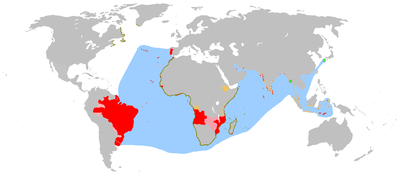Daman and Diu
Daman and Diu (/dəˈmɑːn ... ˈdiːuː/; Portuguese: Damão e Diu; ![]()
| Daman and Diu | |||||||||
|---|---|---|---|---|---|---|---|---|---|
| Former union territory | |||||||||
| 1987–2020 | |||||||||
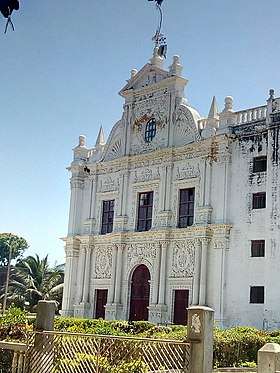 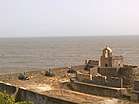 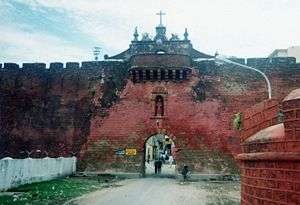 St. Paul’s Church, Diu fort, Gate of Diu | |||||||||
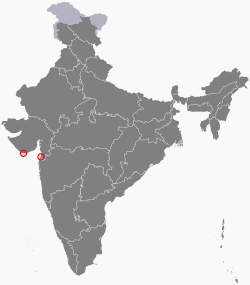 Map of Daman and Diu | |||||||||
| Capital | Daman | ||||||||
| Area | |||||||||
• | 112 km2 (43 sq mi) | ||||||||
| Population | |||||||||
• | 242,911 | ||||||||
| Government | |||||||||
| Administrator | |||||||||
• 1987 (first) | Gopal Singh | ||||||||
• 2019 (last) | Praful Khoda Patel | ||||||||
| History | |||||||||
• Established | 30 May 1987 | ||||||||
• Formation of Dadra and Nagar Haveli and Daman and Diu | 26 January 2020 | ||||||||
| Political subdivisions | 2 districts | ||||||||
| |||||||||
History
For over 450 years, the coastal enclaves of Daman (Portuguese: Damão) and Diu on the Arabian Sea coast were part of Portuguese India, along with Goa and Dadra and Nagar Haveli. Goa, Daman and Diu were incorporated into the Republic of India on 19 December 1961, by military conquest. Portugal did not recognise the Indian annexation of these territories until the Carnation Revolution of 1974.
The territory of Goa, Daman and Diu was administered as a single union territory until 30 may 1987, when Goa was granted statehood, leaving Daman and Diu as a separate union territory. Each enclave constituted one of the union territory's two districts. Daman and Diu are approximately 650 kilometres away from each other by road.
In December 2019, the Parliament of India passed legislation to merge Daman and Diu with the nearby union territory of Dadra and Nagar Haveli to create a new union territory to be known as Dadra and Nagar Haveli and Daman and Diu.[4][5][6]
Demographics
- Literacy
According to the 2011 census, Daman and Diu had a literacy rate of 87.1%, higher than the national average of 74.04%.[7] Male and female literacy rates are 91.5 and 79.5 percent respectively.
- Sex ratio
According to the 2011 census, the lowest female-to-male ratio in India (618 females per thousand males) was recorded in Daman and Diu.[8] The Daman district, with a female-to-male ratio of 0.533, is among the lowest of all the districts.
- Religion
Hinduism was by far the most common religion in Daman and Diu. Muslims were the second-largest religious group in the territory, followed by Christians.
The Catholic Christians of Daman and Diu are pastorally served by the Metropolitan Roman Catholic Archdiocese of Goa and Daman, which has its see in Goa, the primatial see of India.
- Languages
Gujarati was the mother tongue of most of the territory's population, as they belong to the Gujarati-speaking Damaniya sub-caste. Along with Gujarati, Hindi and English are also widely used. Daman and Diu were once part of a combined union territory along with Goa (a Konkani-speaking region), before Goa became a state in 1987.
The use of Portuguese, which was the territory's official language during the colonial period, is in decline and relegated to home use. It is also used as a liturgical language by the territory's Catholics. Standard Portuguese exists in a post-creole continuum while Daman and Diu Portuguese is spoken by about 10,000–12,000 people in Daman.
The languages taught in schools in Daman and Diu under the three-language formula were:[11]
- First language: Gujarati
- Second language: Hindi
- Third language: English
| Population growth | |||
|---|---|---|---|
| Census | Population | %± | |
| 1951 | 49,000 | — | |
| 1961 | 37,000 | −24.5% | |
| 1971 | 63,000 | 70.3% | |
| 1981 | 79,000 | 25.4% | |
| 1991 | 102,000 | 29.1% | |
| 2001 | 158,000 | 54.9% | |
| Source:Census of India[12] | |||
Administration
According to the Constitution of India, the administration of Daman and Diu was carried out by an Administrator, appointed by the President of India as an agent of the President, not a head of state/government or a governor. He was assisted by a number of other officers in carrying out his duty. Currently, this post is held by Praful Khoda Patel.
- Districts
The union territory of Daman and Diu had two districts:
- Diu District, an area of 40 km2 (15 sq mi). The main settlement is the town of Diu.
- Daman District, an area of 72 km2 (28 sq mi). The main settlement is the city of Daman.
Gallery
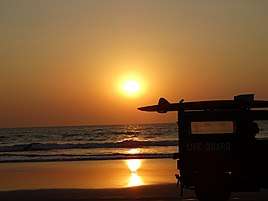 At devka beach daman, sun is doing magic
At devka beach daman, sun is doing magic- Moti Daman Fort, Daman, Daman and Diu
- Fort of Nani Daman/Fort of St.Jerome
.jpg) Jain Temple, Daman
Jain Temple, Daman.jpg) A PERSPECTIVE VIEW OF ST PAUL CHURCH AT DIU
A PERSPECTIVE VIEW OF ST PAUL CHURCH AT DIU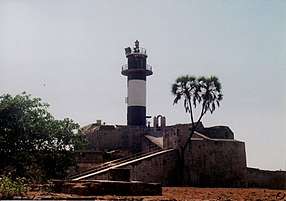 Diu fort tower
Diu fort tower
See also
- Battle of Diu
- Damania
References
- Staff, The ID (4 December 2019). "Dadra & Nagar Haveli and Daman & Diu UTs merge for 'better admin efficiency, service': MoS Home". Indus Dictum. Retrieved 5 December 2019.
- Ward (1998). Gujarat–Daman–Diu: A Travel Guide. Orient Longman Limited. ISBN 9788125013839.
- Singh, K. S.; Solanki, B. R.; Sinha, N. K.; Pereira, Jaime F. (1994). Daman and Diu. Popular Prakashan. ISBN 9788171547616.
- Dutta, Amrita Nayak (10 July 2019). "There will be one UT less as Modi govt plans to merge Dadra & Nagar Haveli and Daman & Diu". The Print. Retrieved 22 August 2019.
- "Govt plans to merge 2 UTs -- Daman and Diu, Dadra and Nagar Haveli".
- http://164.100.47.4/BillsTexts/LSBillTexts/Asintroduced/366_2019_LS_Eng.pdf
- census 2011
- "Ranking of States and Union territories by population size : 1991 and 2001" (PDF). Government of India (2001). Census of India. pp. 5–6. Archived (PDF) from the original on 2 January 2014. Retrieved 12 May 2012.
- "Daman and Diu". Archived from the original on 21 June 2018. Retrieved 4 July 2018.
- "Language – India, States and Union Territories" (PDF). Census of India 2011. Office of the Registrar General. pp. 13–14. Archived (PDF) from the original on 14 November 2018. Retrieved 4 December 2018.
- "51st REPORT OF THE COMMISSIONER FOR LINGUISTIC MINORITIES IN INDIA" (PDF). nclm.nic.in. Ministry of Minority Affairs. 15 July 2015. p. 125. Archived from the original (PDF) on 16 February 2018. Retrieved 15 February 2018.
- "Census Population" (PDF). Census of India. Ministry of Finance India. Archived from the original (PDF) on 19 December 2008. Retrieved 18 December 2008.
External links
| Wikiquote has quotations related to: Daman and Diu |
| Wikivoyage has a travel guide for Daman and Diu. |
